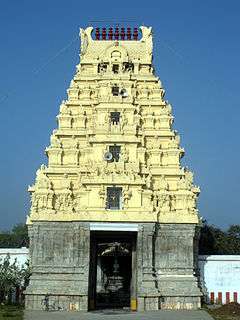Thirumarperu
| Thirumarperu திருமால்பூர் | |
|---|---|
 | |
 Thirumarperu திருமால்பூர் Location in Tamil Nadu | |
| Geography | |
| Coordinates | 12°57′24″N 79°40′25″E / 12.95667°N 79.67361°ECoordinates: 12°57′24″N 79°40′25″E / 12.95667°N 79.67361°E |
| Country | India |
| State | Tamil Nadu |
| District | Kanchipuram |
| Location | Tirumalpur |
| Culture | |
| Primary deity | Maal Vanangia Eesar, Manikandeswarar (Shiva) |
| Consort | Karunai Nayaki, Anjanakshi (Parvathi) |
| Architecture | |
| Architectural styles | Dravidian architecture |
Thirumarperu Manikandeswarar Temple (Tamil: திருமால்பூர்) is a Hindu temple dedicated to Shiva located in Tirumalpur in Ocheri -Tirumalpur road, Tamil Nadu, India. The temple is revered by the Tevaram hymns of 7th century Saiva nayanars - Tamil saint poets and is also classified as a Paadal Petra Sthalam (temple revered by the nayanars).
The Temple
Vishnu (called Tirumal) is believed to have worshipped Shiva in this temple and hence the name Thirumalpur.[1] The temple has a four-tiered rajagopuram (temple tower). The temple has set of inscriptions from Chola period of Rajaraja Chola I (985 – 1014 CE).[2] Appar, the 7th-century saint poet glorified the deity in Tevaram in one verse.[3][4][5] The temple is also referred as Hari-chakrapuram. The Nandi (sacred bull of Shiva) is in standing portion in this temple unlike other Shiva temple where Nandi is in sitting posture.[5] The temple tree is Bilva.[5]
Reaching the Temple: The temple is situated on the Kancheepuram to Arrakonam route. It is approximately 13 Kilometres from Arrakonam. From Kancheepuram it is approximately 17 Kilometres. There is a railway station in Thirumalpur, but it is a smaller one. The nearest railway junction is Arrakonam. The temple is also easily accessible from Govindavadi temple (App. 5 Kilometres).
Temple Timings: The temple is closed between 1 PM to 4 PM.
Legend
Some of the local tradition indicates Tirumalpur as the place where Vishnu asked Mahabali Chakravarthy to give him land of the extent measured by three steps of Vishnu.[6]
Notes
References
- Ayyar, P. V. Jagadisa (1991), South Indian shrines: illustrated, New Delhi: Asian Educational Services, ISBN 81-206-0151-3
- Prentiss, Karen Pechilis (1999), The embodiment of bhakti, New York: Oxford University Press, ISBN 0-19-512813-3
- Khanna, Meenakshi (2007), Cultural History of Medieval India, New Delhi: Social Science Press, ISBN 978-81-87358-30-5
- Anand, Swami P.; Parmeshwaranand, Swami (2004), Encyclopaedia of the Śaivism, New Delhi: Sarup & Sons, ISBN 81-7625-427-4
- Soundara Rajan, Kodayanallur Vanamamalai (2001), Concise classified dictionary of Hinduism By Kodayanallur Vanamamalai Soundara Rajan, New Delhi: Concept Publishing Company, ISBN 81-7022-857-3.
